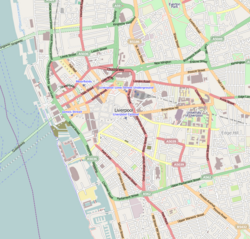 The top of Bold Street, March 2022 | |
| Location | Ropewalks, Liverpool city centre |
|---|---|
| Postal code | L1 |
| Coordinates | 53°24′10″N2°58′40″W / 53.40278°N 2.97778°W |
| Other | |
| Known for |
|
Bold Street is a street in Liverpool, England. It is known for its concentration of independent businesses and for the Church of St Luke (locally known as the "bombed-out church"), which is situated at the top end of the street. The bottom end leads into the area surrounding Clayton Square, which is part of the main retail district of central Liverpool. The bottom end contains more shops which are chain stores. Liverpool Central, a major hub of the Merseyrail rapid transit/commuter rail network, can also be accessed via an entrance on Bold Street next to The Lyceum, a post office which was Europe's first lending library. The middle area contains bars as it leads towards Concert Square, a square containing clubs and bars, and the top end contains more independent shops and cafes. For the most part, Bold Street is pedestrianised and cars do not have access.



